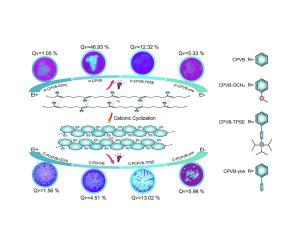European Polymer Journal ( IF 5.8 ) Pub Date : 2024-01-20 , DOI: 10.1016/j.eurpolymj.2024.112760
Siwei Chen , Hongyuan Bai , Hongwei Ma , Li Han

|
With the emergence of new emissive species in many nonconjugated structures, how to efficiently design and manipulate non-traditional intrinsic luminescence luminogens (NTILgens) is of academic importance but a dramatic challenge. As the carbon skeletons in olefin polymers have diverse microstructures that mainly affect molecular packing, the construction of the carbon skeletons is required to regulate the performances of luminescent materials. Our group previously reported the C5 skeletal P-CPVB and its ladder polymer (C-PCPVB) through the anion migrated ring-opening polymerization (AMROP) of 1-cyclopropylvinylbenzene (CPVB) and the cationic cyclization of P-CPVB. Unexpected, after the rigid seven membered rings were constructed among the phenyl rings, the NTIL was observed of the nonconjugated C-PCPVB in the aggregate state under UV light irradiation. The results inspired us to design the polymer luminogens through the construction of carbon skeletons. In present work, the P-CPVBs and their ladder polymers (C-PCPVBs) with different degree of polymerization (DPs) are prepared. Unexpected, P-CPVBs with different DPs were non-emissive in dilute solution but highly emissive with the visible light in the solid state under the UV light irradiation. As predicted, C-PCPVBs with different DPs fluoresced blue emission in the aggregation state. All the P-CPVBs in the solid state showed much higher absolute quantum yields (QY) values than C-PCPVB analogues did. The bright blue emissions in the aggregate state of both C-PCPVBs bearing nonconjugated groups and P-CPVBs bearing poorly conjugated groups could be attributed to the clusterization-triggered emission (CTE), but the mechanisms to generate NTIL were different due to the difference of the carbon skeletons, where the through-spacing conjugation (TSC) and through-spacing interactions (TSI), respectively, contributed to the NTIL of C-PCPVBs and P-CPVBs. In perspective of the property-oriented designability, their derivatives with different electron-donating and -withdrawing substituents (P-CPVB-OCH3/TPSE/yne, C-PCPVB-OCH3/TPSE/yne) when the DPs were fixed at 24 were synthesized and characterized. All the substituted P-CPVBs/C-PCPVBs were demonstrated with the aggregation-induced emission (AIE) effect and blue fluorescence as the unsubstituted P-CPVBs/C-PCPVBs. As desired, the electronic effect of carbon skeletons and their cyclization can affect their maximum emission wavelengths (λem) and the QY. All the λem values were red-shifted whether the carbon skeletons were cyclic or substituted. More importantly, the glass temperature (Tg) and decomposition temperature (Td) of P-CPVB were dramatically improved by the substituents and cyclization analogues. The seven-membered ring and the crosslinking networks of the yne group in the warming up can significantly improve the stability of polymers, contributing to the higher Td value. It should be noted that P-CPVB-yne and C-PCPVB-yne exhibited the much higher Td values, and they showed the higher carbonization yield of 49.78% and 45.25% at 800 ℃, respectively, which would broaden their applications of these nonpolar polymers.
中文翻译:

由聚苯乙烯衍生物 C5 骨架聚合物和具有良好调控微结构的梯形聚合物制成的非传统本征发光发光体
随着许多非共轭结构中新的发光物质的出现,如何有效地设计和操纵非传统的内源发光发光体(NTILgens)具有重要的学术意义,同时也是一个巨大的挑战。由于烯烃聚合物中的碳骨架具有主要影响分子堆积的不同微观结构,因此需要碳骨架的结构来调节发光材料的性能。我们课题组之前报道了通过1-环丙基乙烯基苯(CPVB)的阴离子迁移开环聚合(AMROP)和P-CPVB的阳离子环化,制备了C5骨架P-CPVB及其梯形聚合物(C-PCPVB)。出乎意料的是,在苯环之间构建刚性七元环后,在紫外光照射下观察到聚集态非共轭C-PCPVB的NTIL。结果启发我们通过构建碳骨架来设计聚合物发光体。在目前的工作中,制备了具有不同聚合度(DP)的P-CPVB及其梯形聚合物(C-PCPVB)。出乎意料的是,具有不同DP的P-CPVB在稀溶液中不发光,但在固态下在紫外光照射下具有高可见光发射性。正如预测的那样,具有不同 DP 的 C-PCPVB 在聚集状态下发出蓝色荧光。所有固态 P-CPVB 均表现出比 C-PCPVB 类似物高得多的绝对量子产率 (Q Y ) 值。带有非共轭基团的 C-PCPVB 和带有不良共轭基团的 P-CPVB 在聚集状态下的亮蓝色发射可归因于簇化触发发射(CTE),但由于碳骨架,其中通过空间共轭(TSC)和通过空间相互作用(TSI)分别贡献了C-PCPVB和P-CPVB的NTIL。从性能导向的可设计性角度来看,当DP固定为24时,它们具有不同给电子和吸电子取代基的衍生物(P-CPVB-OCH 3 /TPSE/yne、C-PCPVB-OCH 3 /TPSE/yne)进行了合成和表征。所有取代的P-CPVBs/C-PCPVBs均与未取代的P-CPVBs/C-PCPVBs一样具有聚集诱导发射(AIE)效应和蓝色荧光。根据需要,碳骨架及其环化的电子效应可以影响它们的最大发射波长(λ em)和 Q Y。无论碳骨架是环状还是取代,所有 λ em值都会发生红移。更重要的是,玻璃化温度(Tg )和分解温度(Td ))的P-CPVB通过取代基和环化类似物得到显着改善。七元环和炔基在升温过程中的交联网络可以显着提高聚合物的稳定性,有助于获得更高的T d值。值得注意的是,P-CPVB-yne 和 C-PCPVB-yne 表现出更高的T d值,并且在 800 ℃ 时表现出更高的碳化率,分别为 49.78% 和 45.25%,这将拓宽它们的应用范围。非极性聚合物。































 京公网安备 11010802027423号
京公网安备 11010802027423号